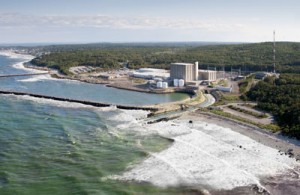HYANNIS – The Pilgrim Nuclear Power Plant in Plymouth will be shut down this spring and Nuclear Regulatory Commission officials provided an update to the public Tuesday on the upcoming procedures to decommission the plant.
It was the first opportunity for the public to hear details about Entergy’s plans to shut down the facility and the proposed sale to Holtec for the decommissioning process.
The agency hosted a webinar that provided a history of the Pilgrim plant, the steps that must be taken prior to its shutdown, the ultimate goal of decommissioning, the timetable and how spent fuel will be handled.
The plant began operations in December on 1972 after receiving an operating license earlier that summer.
Entergy applied for a 20 year-renewal of its license in 2006 which was granted by the NRC in 2012.
Just three years late the company informed the NRC of its intent to shut down the plant no later than June 1 of this year.
Several steps must be taken before a plant can shut down. Once the reactor has been operated for the last time the plant operator must submit a written certification of permanent cessation of operations to the NRC.
When the nuclear fuel has been permanently removed from the reactor vessel the owner must submit another written certification to the NRC.
Within two years of permanent shutdown the NRC requires the submission of a Post Shutdown Decomissioning Activities Report, or PSDAR.
“Entergy and Holtec are way ahead of the curve having submitted their PSDAR’s for Pilgrim on November 16, 2018,” said Bruce Watson, the chief of the NRC’s Reactor Decommissioning Branch.
Because the proposed sale of the plant to Holtec is still under review by the NRC, both companies are required to submit a PSDAR.
Major decommissioning work cannot be performed until after the certifications of the shut down and fuel removal from the core have been received.
“Our current understanding is that Entergy is not planning any major decommissioning work at Pilgrim anytime in the near future,” Watson said.
“And of course, Entergy’s and Holtec’s joint application for the transfer of the plant license is still under review and therefore Holtec cannot perform any work at the site at this time.”
The goal of the decommissioning process is to ensure any residual radioactivity is within the federal limits and the site may be released for unrestricted uses in the future.
“The state may impose additional cleanup requirements on the owner,” Watson said.
Plant operators have two options for decommissioning.
One is immediate dismantlement, which is referred to as the DECON alternative. Structures in equipment related to the nuclear power Production are decontaminated and removed.
A second option is placing the facility in storage and then proceeding with dismantlement and cleanup work at a future date, or SAFSTOR.
The Entergy PSDAR would decommission the plant with the SAFSTOR option, and Holtec’s PSDAR would decommission the plant with the DECON alternative.
“The reason for two PSDAR’s is because Holtec’s plan to buy the plant and decommission it in an expedited fashion is still under review by the NRC,” Watson said.
Entergy’s plan would have decommissioning completed by 2080. If the sale to Holtec is approved, that companies plan would be to have decommissioning completed by 2024.
The decommissioning process is made up of three phases: before cleanup, during cleanup and after cleanup.
The before cleanup stage includes getting the plant ready for decommissioning, moving spent fuel to dry cask storage and submitting a PSDAR and updates.
The during cleanup phase includes the removal of structures and components, soil remediation and radioactive waste shipments.
The after cleanup phase includes site restoration, NRC license termination and spent fuel management.
Entergy to Holtec hope to have the equity sale closure and license transfer executed by July 31 with target dates for the actual license transfer and closing of sale agreement by the end of 2019.
If the sale is not approved, Entergy’s plan would have the plant in a period of SAFSTOR dormancy until 2073. Preperations for and the dismantlement and decontamination would occur through 2078 with restoration following until 2080.
A sale to Holtec would begin major decommissioning as early as the end of this year and continuing through 2023. Radiological decontamination of the site would be wrapped up by 2024. A license termination plan would be submitted as early as 2021 with hopes of receiving NRC approval within two years.
Site restoration activities would begin in non-radiological areas after demolition of buildings and structures in 2024.
“Holtec estimates that parts of the site will be released through partial site relief beginning as early as 2025,” said Amy Snyder, a senior project manager in the Reactor Decommissioning Branch.
In terms of spent nuclear fuel, Pilgrim has already loaded 17 dry casks with spent fuel.
The fuel sits in a stainless steel cask that is surrounded by a think concrete overpack. Vents at the top and bottom allow for air flow to keep the fuel cool.
In October, Entergy announced plans to build a new independent spent fuel storage installation at a higher elevation at the site.
“That facility would hold all of the already loaded casks and the casks holding the remained of Pilgrim’s spent fuel,” said Katherine Warner, a health physicist in the Division of Nuclear Material Safety for the NRC.
A total of 61 casks will eventually be housed at the site. Entergy, or Holtec if the license transfer is approved, would be responsible for maintaining the safety and security of the fuel until it is accepted by the federal government, specifically the Department of Energy, for disposal.
Public comments will be accepted for the PSDARs until March 21.
The Nuclear Regulatory Commission staff will hold a public meeting on January 15 in Plymouth to discuss a decommissioning roadmap report for the Pilgrim nuclear power plant.
Attendees will be able to provide comments at the meeting.
The meeting is scheduled to begin at 6 p.m. at Hotel 1620 on Water St.






















